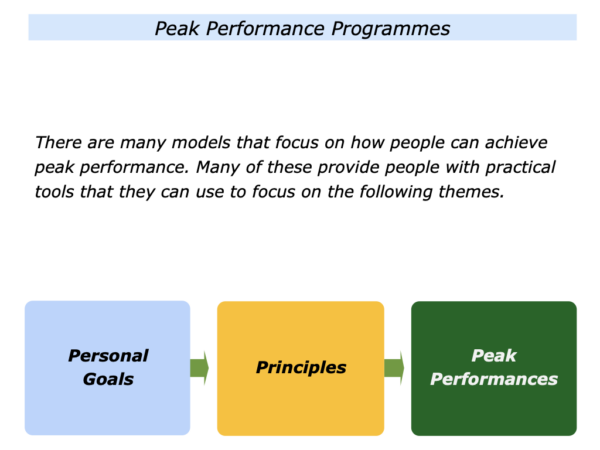
During the past fifty years there have been many books and programmes that focus on how people can achieve peak performance. Whilst each of these tend to emphasise their own approach, many of them provide practical tools on the following themes.
Personal Goals
This involves focusing on a person’s goals – these can be both their personal and professional goals.
Principles
This involves focusing on the principles a person can follow – and how they can translate these into practice – to achieve their goals.
Peak Performances
This involves focusing on how a person can do their best to deliver peak performances on their way towards achieving their goals.
Some programmes also focus on how teams and organisations can translate these themes into action. They then provide tools that people can use coordinate their talents to achieve peak performance.
The Modern Interest
In Peak Performance
Much of the modern interest in peak performance stems from the work done by people in sports, business and and other fields. As we will see later, however, many of these principles have been followed by people throughout history.
Charles Garfield inspired people to pursue these themes. Writing in his 1986 book Peak Performers he encouraged people to become the best they could be. He wrote:
“Do not compete with anyone except yourself.”
He said it is vital for people to work towards a compelling goal. He saw this when working as a computer analyst and leading engineers, scientists and staff on the Apollo 11 project.
Charles also founded the Shanti Project. This is a volunteer organisation that deliver excellence for patients and families facing life-threatening illness.
Alongside this he worked as a clinical professor at the University of California Medical School in San Francisco. Charles said he first heard the phrase peak performance from a cancer patient who said:
“Staying alive these days is my peak performance.”
He remembered the phrase and went on to study great workers in many fields. These included people in medicine, sports, business and the NASA work in which he was participating.
Charles said that towards the end of the 1970s he discovered a common trigger for peak performance. People were often motivated to follow certain principles. They then translated this into pursuing a mission that gave them a sense of purpose.
The key factor, said Charles, was for them to make an internal decision to perform at their best. He wrote:
Now I began to understand what I was hearing and seeing, as one peak performer after another spoke of self-training, learning by experience, organizing that experience around a single theme, speaking and finding a purpose, a personal mission that represents something important.
They were talking about what management theorist Warren Bennis calls ‘working near the heart of things.’
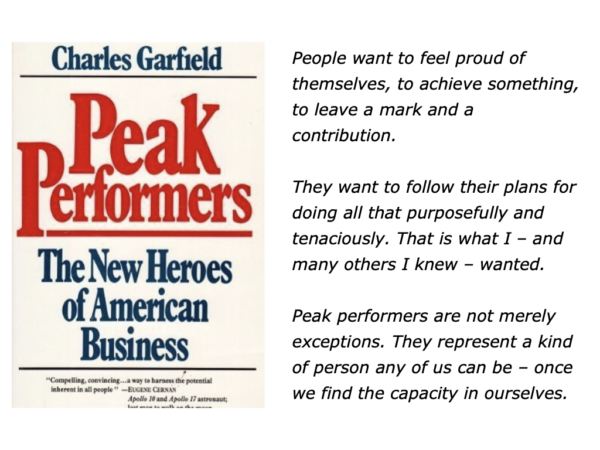
The Different Definitions
Of Peak Performance
There are many definitions for peak performance. These include the following:
Being the best you can be … Being the best version of yourself … Doing extraordinary work … Producing optimal performance … Getting a Perfect 10 (this from a previous measures of performance in gymnastics).
John Wooden, the basketball coach, described something similar in terms of competitive greatness. He explained this in the following way.
Be at your best when your best is needed. Success is peace of mind attained only through self-satisfaction in knowing you have made the effort to do the best of which you are capable.
There are several dictionary definitions of peak performance, some of which are exceptionally long. Several of these can be summarised in the following way.
Peak performance involves being fully focused and applying your abilities to achieve the highest possible level of performance.
There are many philosophical and psychological approaches to delivering such work. Here is one that is drawn from spiritual philosophies but is also applied in sports and other fields.
Peak performance involves going in your equivalent of the zone, following the principles of effortless effort and delivering exceptional performances.
As mentioned earlier, there are several definitions of peak performance. For the moment, let’s focus on a short version. This is:
Being the best you can be.
This definition has its shortcomings but it can be a useful starting point. There is also an interesting paradox when it comes to defining peak performance. This can be explained in the following way.
Doing your personal best – your personal peak performance – may not equate to what others consider to be peak performance.
Let’s look at one example. This is one from sports but it can apply in other fields.
You may run 100 metres in 9.4 seconds – which will be your personal peak performance – but the winner may run it in 9.3 seconds.
You can still aim to be the best you can, however, and continue to improve. This involves focusing on the following themes.
You can do your best to achieve peak performance.
You can recognise that other people’s natural talents may sometimes lead to them achieving higher levels of performance.
You can continue to improve, however, and aim to achieve your highest level of peak performance.
The Historical Approaches
To Peak Performance
Many writers, researchers and practitioners have contributed to our understanding of this field. Some refer back to Eastern and Western philosophies that describe ways of being that are akin to what we now call flow. Pursuing these paths can contribute to peak performance.
Alison Coleman describes these in a piece she wrote for the Iwoca website. Here is an excerpt from her article.
It’s been called many things over the centuries in both Western and Eastern philosophical writing, but the concept of being ‘in the flow state’ or ‘in the zone’ is almost universal across civilisation.
The ancient Japanese martial artists are credited with coining the term ‘mushin’ which originates from ‘mushin no shin’. This is a Zen term for ‘mind of no mind’.
It describes a heightened state of awareness where thoughts or emotions no longer get in the way of achieving peak human performance. This concept still remains central to Japanese martial arts today.
In Chinese history, the philosophy of flow is referred to as ‘wu wei’, which means effortless action or effortless doing. In some traditions of ancient India the concept of samyama is a form of flow state, sharing many similarities with mushin and wu wei.
The scientific study of flow began early in the 20th century when Harvard researcher William James began exploring and recording how the human brain can alter consciousness to improve performance.
One of his students, physiologist Walter Bradford Cannon, discovered a link between mind and body that helped to explain how the brain is able to reach a state that amplifies performance.
The ScienceDirect website refers back to Greek historical thought and describes the concept of eudaimonia. It defines this in the following way.
Eudaimonia and concepts of the good life and human flourishing have been of central concern for philosophy and not least with reference to Aristotelian thought.
This is a state attained by an individual living their life with the moral boundaries set by their virtues and fulfilling their roles and attaining their goals in life.
Catherine Moore explores the concept of eudaimonia in an article she wrote for the Positive Psychology website. Here is how it is defined.
Eudaimonia is a process of fulfilling or realizing one’s daimon or true nature. It is fulfilling one’s virtuous potentials and living as one was inherently intended to live.
The Self-Help And
Self-Improvement Influences
Some of the early self-help and self-improvement literature influenced later approaches to peak performance. These encouraged individuals to have a positive attitude, take responsibility and fulfil their potential.
Many people are familiar with writings of people such as Norman Vincent Peale. There were other writers, however, who preceded his work. Let’s look at one such person.
James Allen was born in Leicester in 1864 and spent much of his life in the manufacturing industries. In 1902 he moved to Ilfracombe, Devon, and devoted the rest of his life to writing.
He believed we could control our thoughts. We could then spread goodness by translating these thoughts into action. Here are some of the things he wrote. (As you will see, he used the term ‘man’ when referring to both men and women).
A man sooner or later discovers that he is the master-gardener of his soul, the director of his life.
All that you accomplish or fail to accomplish with your life is the direct result of your thoughts. Our life is what our thoughts make it.
Good thoughts bear good fruit, bad thoughts bear bad fruit. No duty is more urgent than that of returning thanks.
The law of harvest is to reap more than you sow. Sow an act, and you reap a habit.
Sow a habit and you reap a character. Sow a character and you reap a destiny.
The more tranquil a man becomes, the greater is his success, his influence, his power for good.
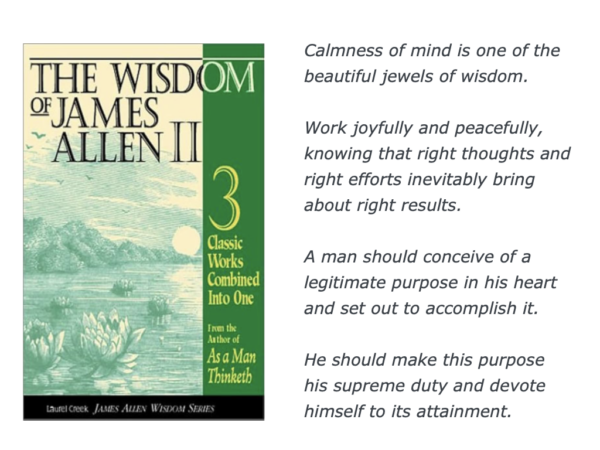
The More Recent Approaches
To Peak Performance
Charles Garfield inspired people with his work on peak performance. Many other writers and practitioners focused on these theme. Different people did this in different ways.
Some learned from their own experiences of delivering great work. Some studied great performers in sports, business and other fields. Some produced their own models for delivering high performance.
Many people have since produced books on this topic. Such books often focus on one or more of the following themes – Positive Models, Personal Journeys or Practical Tools. Some combine all three elements.
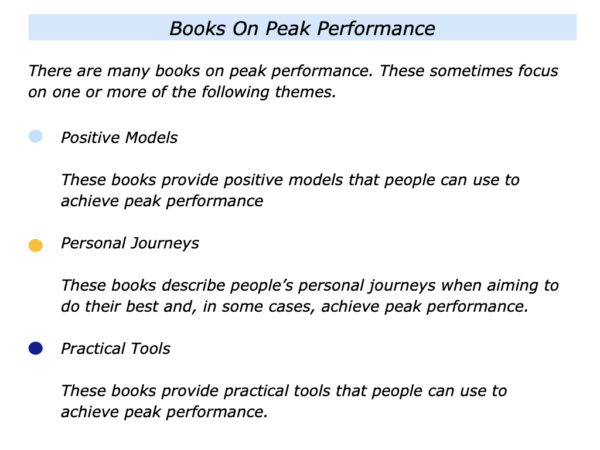
Positive Models
Some of these books aim to study peak performance and pass on positive models that people can use in their own ways. Let’s consider some that fall under this heading.
During the 1970s and 80s there was increased interest in sports psychology and how it could increase performance. This often involved helping athletes:
To revisit the times when they had performed superbly and clarify the principles they followed to deliver peak performance;
To clarify how they could follow these principles in the future to deliver peak performance;
To mentally rehearse following these principles in a forthcoming situation and then do their best to deliver peak performance.
Willi Railo, a Norwegian sports psychologist, wrote an influential book on the topic. Published in 1983, it was called Bäst när det gäller – which roughly translated means Best When It Matters. This provided a positive model that sports people could use to perform at their best.
Tim Gallwey helped athletes to develop by focusing on what he called the inner game. From the early 1970s he published many books on this theme. These included The Inner Game of Tennis, The Inner Game of Golf, The Inner Game of Skiing and The Inner Game of Work.
Tim said individuals had two selves within their inner game. Self 1 was the negative or critical self that a person may have learned over the years. This could create noise and stop the person performing.
Self 2 was the positive and creative self. It embodied the passionate, curious and non-judgmental approach they may have had as a child. This could be revitalised to enable them to perform superbly.
Different people applied Tim’s ideas in different fields. One coach summarised how they used it in the following way.
The Inner Game And The Outer Game
People who play sports may focus on both their inner game and the outer game. The inner game is played within the person and involves have a positive or negative approach. The outer is played in an external arena and involves aiming to reach an external goal.
The inner game can be played in a positive way. It is for the person to have a positive attitude, be present in the moment and do their best. It is to focus on the process and be non-judgemental.
The inner game can also be played in a negative way. It is for the person to be negative, fearful and unfocused. This can lead to self-doubt and poor performance.
My role is it help people to develop their positive inner game and do their best when playing the outer game. They are then more likely to achieve peak performance.
Mihaly Csikszentmihalyi did much of the pioneering work on flow. He described this in his books Flow: The psychology of optimal experience and Creativity: Flow and the psychology of discovery and invention.
Mihaly studied individuals, artists, doctors and other people who had what he called flow experiences. Such people followed certain principles.
They chose to work towards a stimulating goal. They concentrated fully and used their skills to do fine work. They became so absorbed in the activity that time went away. They reached the goals and had a sense of fulfilment.
Mihaly provided a framework people could follow in their own way. Here is a summary of this approach which could lead to peak performance.
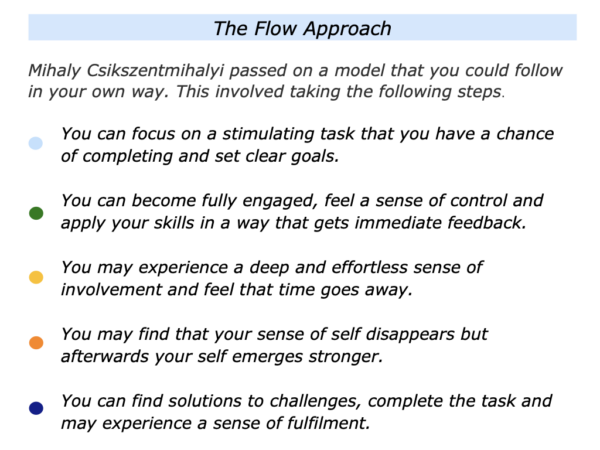
Many other people created models for achieving peak performance. Some chose, however, to focus on the following theme.
Personal Journeys
Some people describe their personal journeys towards doing their best. They aim to show rather than tell and share experiences from their lives and work.
Many such books are written by or about women. They describe the journeys taken by women artists, explorers, scientists, mountaineers and change makers.
People often feel inspired and learn from such stories. They feel encouraged to be their authentic selves and follow their chosen path in life. They then aim to be the best they can be.
Here are two of the most well-known autobiographies – from Maya Angelou and Malala Yousafzai.

Brené Brown reached a wide audience with her TED talk on vulnerability and her book Daring Greatly. She also explored the following theme.
What are the qualities demonstrated by people who live wholeheartedly?
She found that such people are prepared to be real and live with their imperfections. They focus on joy and gratitude. They give themselves to life and are prepared to live with uncertainty.
Brené went on to offer what she called Ten Guideposts that people could follow in their own way. Here is an overview of those themes.

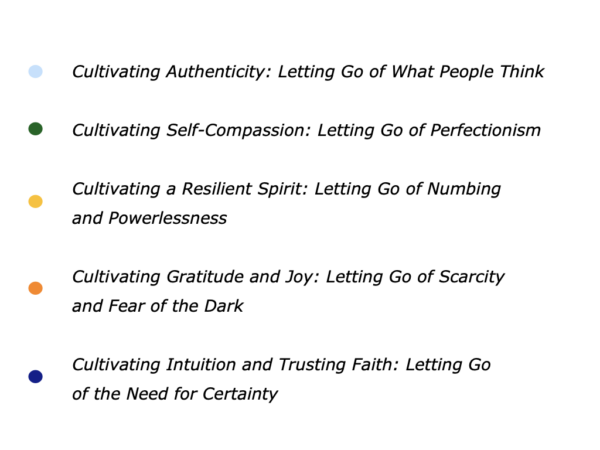
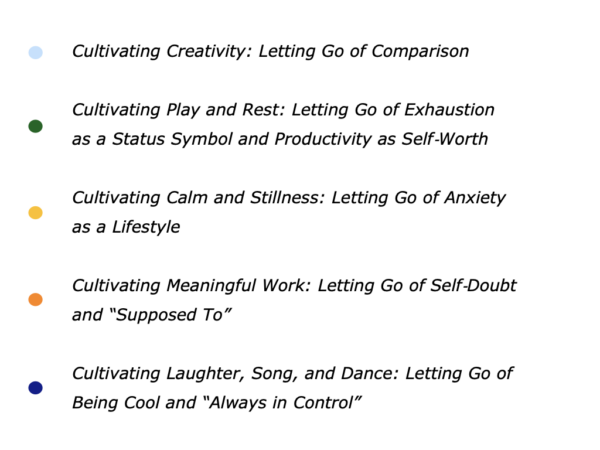
Practical Tools
Some writers and practitioners aim to offer practical tools that people can use to achieve peak performance. Some focus on a specific activity whilst others take a more wholistic approach.
Alan Lakein, for example, encouraged people to channel their energies towards achieving their life goals. In 1973 he published How To Get Control Of Your Time And Your Life.
This book offered many tools that people could use to achieve their goals. It also spurred a growth in people offering course in Time Management and Priority Management.
Stephen Covey popularised these and other tools in his book The 7 Habits of Highly Effective People. He also introduced people to other techniques for being effective and doing excellent work.
John Whitmore and his colleagues produced the practical GROW Model. This encouraged a person to focus on: a) their goal; b) the realities; c) their options; c) their will to do the work involved to reach the goal. This became the basis for many coaching programmes.
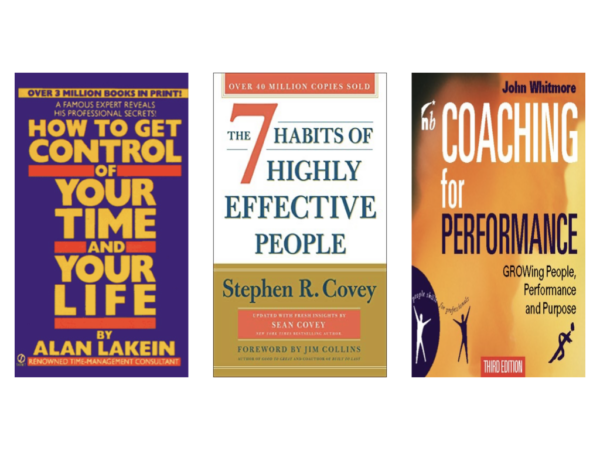
Some practitioners pursued the strengths approach. They provided practical tools that people could use to build on their strengths, follow strategies that worked and achieve their picture of success.
Tom Rath headed the Gallop Organization’s approach to helping people to build on their strengths. He then moved on to providing practical tools that people could use to take care of their wellbeing. These can be found in his books Eat Move Sleep and Are You Fully Charged?
The rise of positive psychology has led to many books and programmes that provide practical tools that people can use to flourish. Some of these focus on the topic of happiness.
Tal Ben-Shahar ran one of Harvard’s most popular programmes which provided tools people could use to focus on happiness. He described some of these in his best-selling books Happier and Being Happy.
Sonja Lyubomirsky made a scientific study of people who were happy. This led to her producing the book of practical ideas called The How Of Happiness: A New Approach To Getting The Life You Want.

Steve Peters is a psychiatrist who has enabled many athletes to deliver peak performances. He describes the brain as comprising of three interacting parts. These are the human, the computer and the chimp.
The chimp can get out of control and produce negative thoughts. Steve shows people how can do great work by managing their chimp and rising to the occasion when it matters. He describes the techniques for doing this in his books such as The Chimp Paradox.
The past twenty years has seen a rise in programmes that encourage people to focus on their purpose. Many owe their origins to Viktor Frankl’s work and his book Man’s Search For Meaning.
Some programmes help people to clarify their purpose. They then provide them with practical tools they can use to follow their principles and, when appropriate, achieve peak performance.
There are now programmes that help people to manage the challenges of what has been called a VUCA World. This is a world that is full of volatility, uncertainty, complexity and ambiguity.
The acronym VUCA has become a cliché but people may still need help to manage such situations. One approach is to provide them with tools they can use to follow their values and thrive in such an environment.
Some writers and practitioners encourage such individuals to build on their unique strengths. They provide tools that people can use to channel their personalities rather than change their personalities.
People are different. Some are introverts, some are extroverts, some move between these ways of operating. Some behave in ways that could be considered bipolar, autistic or having elements of ADHD.
Susan Cain provided many such tools for people who may be considered to be introverts. She wrote Quiet: The power of introverts in a world that can’t stop talking. This enabled many introverts to continue to build on their strengths and do superb work.

Running Peak Performance Sessions
There are many ways to run such a session. Different mentors, for example, will have different philosophies about the principles people can follow to achieve peak performance.
Whatever their views, however, they will prepare properly. Different people will do this in different ways. One approach is for them to explore the following questions.
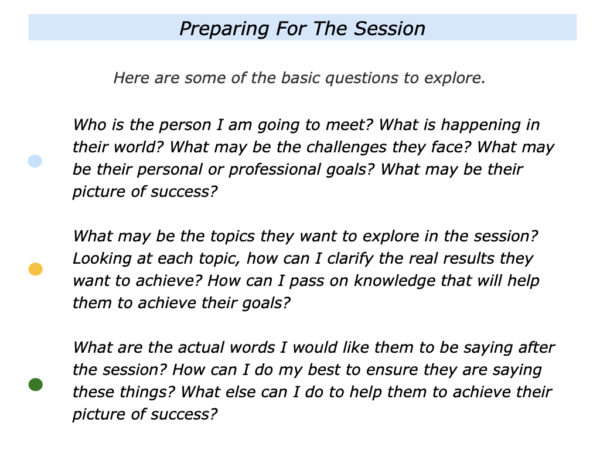
The mentor will aim to create a positive environment in which the person feels at ease and able to explore. They may then focus on the following steps to when helping theme to achieve peak performance.
Personal Goals – Establishing Clarity About
The Real Results The Person Wants To Achieve
This step involves focusing on a person’s goals. These can be personal, professional or peak performance goals. It is important to make clear contracts about the outcomes – the real results – the person want to achieve.
One approach is for the mentor to welcome the person to the session and explain the approach they will use. They may do this by saying something along the following lines. They will, of course, do this in their own way.
Welcome to the session. As you know, we can explore any topics you wish. These can be things you want to focus on as a person, as a professional or as somebody who wants to achieve peak performance.
For example: How to build on your strengths … How to tackle specific challenges … How to achieve peak performance … How to achieve your picture of success … Or any topics.
We will start by clarifying the various topics you want to discuss. We will focus on the first one you want to explore and clarify the real results you want to achieve.
We will then clarify the principles you can follow to do your best to achieve these aims. If you wish, I can also share practical ideas that you can use in your own way to achieve your picture of success.
We will then move on to the action part. If appropriate, we will focus on how you can translate your chosen principles into action and work towards you goals.
We will clarify how you can follow strategies that work to achieve the aims. This can include how you can deliver peak performances on the way towards achieving your picture of success.
Are you okay with taking these steps? Are there any other things you would like us to cover?
Different mentors have different philosophies but most will begin by explaining their approach. They will also invite the person to describe the topics the topics they would like to discuss. They will then aim:
To focus on the first topic the person wants to explore and invite them to give some background about the specific situation;
To clarify the specific things the person can control in the situation – such as their attitude, professionalism and other things;
To clarify the person’s specific goals – the real results they want to achieve – and translate these into a clear picture of success.
Imagine the mentor has taken these steps. They will then double check they are clear on what the person wants to achieve. Sometimes this can involve focusing on both their short and long-term aims.
Some mentors then underline the point that Steve Peters often makes to the people with whom he works. The person is encouraged:
To focus on what they can control in the situation and to do their best to achieve the goals.
Bearing these in mind, the mentor may say something along the following lines to make sure they understand the person’s picture of success.
As far as I understand, the
goals you want to achieve are:
To …
To …
To …
Is that right? Are there any other things you want to achieve?
Imagine that the mentor has clarified the goals the person wants to achieve. They may then move on to the next theme to help them to reach their goals.
Principles
This step involves focusing on the principles the person can follow to achieve their goals. Before exploring this step, however, it is important to recognise a key factor that will influence this part of the process.
Different mentors will have different philosophies about the principles that a person can follow achieve their aims. They may also have different approaches to helping a person to translate these principles into action.
There is also another factor to bear in mind. Depending on their approach, the mentor may aim either:
To encourage the person to clarify their own view of the principles they want to follow to achieve peak performance;
To pass on knowledge about some of the principles the person may be able to follow to achieve peak performance.
Some mentors combine both approaches. They help the person to learn from their own experiences and, with their permission, also pass on knowledge the person can use in their own way to achieve their goals.
Imagine that the mentor wants to combine these approaches. Let’s look at how they may take these steps.
The Mentor Clarifying The
Person’s Successful Principles
Everybody has a positive history of tackling challenges or reaching specific goals. It can therefore be useful to help a person to clarify their successful style of achieving their aims.
One approach is to borrow from sports psychology. It is: a) to clarify the principles a person has followed to do superb work in the past; b) to clarify how they can follow those principles – plus add other skills – to do superb work in the future.
Bearing this in mind, the mentor may say something along the following lines to the person.
Let’s start by focusing on your strengths and successful style. We can then explore how to build on these in the present situation.
Looking back, when have you tackled a similar challenge successfully in the past? What did you do right then? What were the principles you followed? How did you translate these into action?
Looking ahead, how can you follow some of these principles to tackle the present challenge? How can you translate these into action? What other skills may you need to add to achieve the picture of success?
This is an organic approach to helping a person to develop. It is encouraging the person by explaining that: a) they already have successful patterns; b) they can build on these – plus add other skills – to achieve their goals.
The Mentor Passing On Knowledge
About Successful Principles
Many mentors have studied what works. They may also, when appropriate, pass on this knowledge about what works. Before doing so, however, the mentor will probably have explored the following questions.
What are the real results the person wants to achieve? What do we know works in these kinds of situations? Bearing this in mind, what is the knowledge I can pass on to help them to achieve their aims?
What are the principles they can follow? What are the positive models they can use? What are the practical tools I can share that will help them to achieve their aims?
How can I pass on this knowledge in a way that they can accept and use? How can I bring it to life with specific examples? How can I do this in a way that resonates with them and helps them to achieve their goals?
Imagine that the mentor wants to share some ideas. Before doing so, however, it is important to get the person’s permission to take this step. They may therefore say something along the following lines.
Bearing in mind the goals you want to achieve, is it okay to share some ideas that we have seen work in similar situations? You can take the ideas you like and use them in your own way.
The person will probably agree. The mentor will then try to pass on this knowledge in a way that the person can accept and use.
Different mentors may, of course, share different ideas. Much depends on their philosophy about the principles people can follow to achieve peak performance. They may believe that it can be useful for a person to do some of the following things:
To focus on a clear purpose, follow their principles and aim to achieve peak performance;
To build on their strengths, follow strategies that work and work to achieve their picture of success;
To focus on their beliefs, do the basics and, when appropriate, add the brilliance;
To follow their values, translate those into a clear vision and deliver visible results;
To aim to do work where they enjoy the journey, be effective and deliver excellence;
To aim to flow, focus, do fine work, finish and, as a by-product, find fulfilment;
To use their personal radar – their ability to see patterns quickly – apply their repertoire and deliver the desired positive results;
To channel their inner champ – focusing on the principles they have followed in the past to perform brilliantly – and manage their inner chimp;
To demonstrate certain characteristics, deliver consistently high standards and add that touch of class;
To follow their passion, be professional and do their best to achieve their picture of success;
To follow other principles to perform superb work and deliver peak performances.
The mentor will then aim to pass on ideas the person can use to achieve their goals. When doing so, it will be important to see which of these ideas resonate with the person.
Sometimes this can be easy because the person may show their interest in a particular topic. If the person is an introvert, however, it can be useful to give them chance to reflect. They may time to process the information and, if appropriate, focus on the ones that resonate.
Imagine the mentor has created such a time for reflection. When appropriate, they may then say something along the following lines.
Looking at the ideas we have mentioned, are there any that it would be good to explore further? We can then look at how to apply these in your particular situation.
Imagine that the mentor has helped the person to clarify the principles they want to follow. They may then move on to the next stage.
Peak Performances
This step involves focusing on how the person can translate their chosen principles and specific plans into action. The person can then do their best to deliver peak performances.
Every person has their own way of making action plans and the mentor will respect their approach. When appropriate, however, they may offer practical ideas the person can use to follow their chosen principles. They may help the person:
To clarify the key strategies they can follow to give themselves the greatest chance of success;
To clarify the specific things they can do to follow these strategies, get some quick successes and do superb work;
To clarify the specific things they can do to find solutions to challenges, keep improving and do their best to deliver peak performances.
As mentioned earlier, different people have different definitions of peak performance. Whatever their view, however, many people aim:
To be the best they can be.
Let’s return to your own life and work. Looking ahead, can you think of a situation where you may want to follow elements of the peak performance programmes approach? How can you do this in your own way?
You may want to follow some of these principles in your own life or work. Alternatively, you may want to follow them to help another person to achieve peak performance.
If you wish, try tackling the exercise on this theme. This invites you to complete the following sentences.
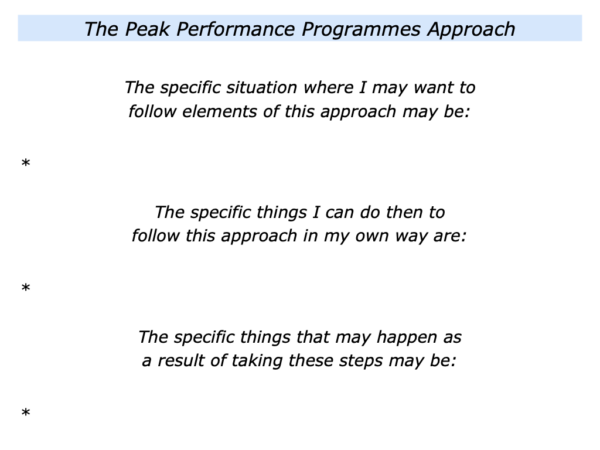


Leave a Reply